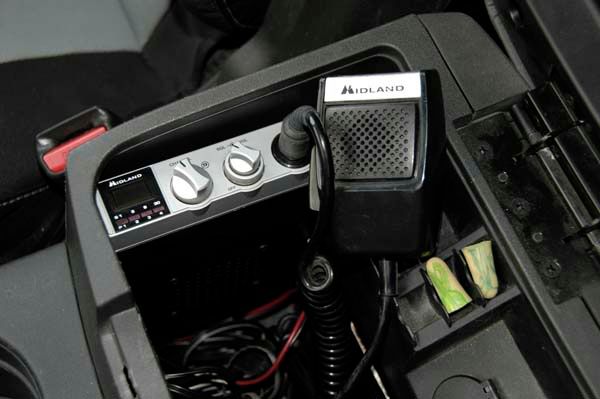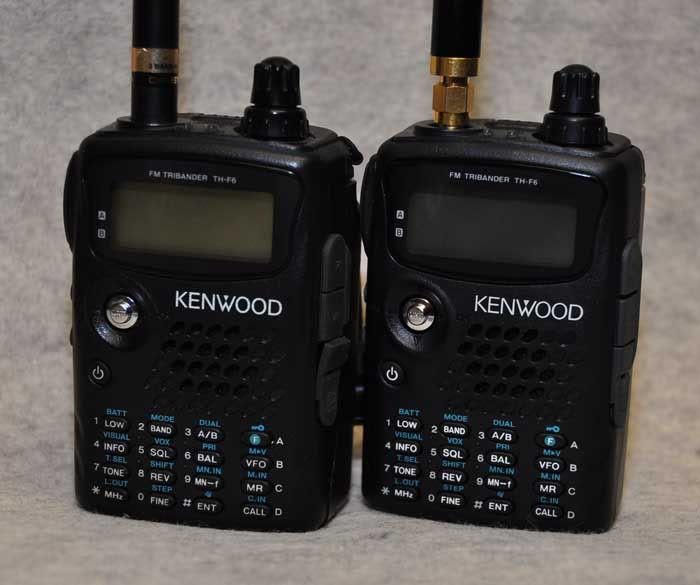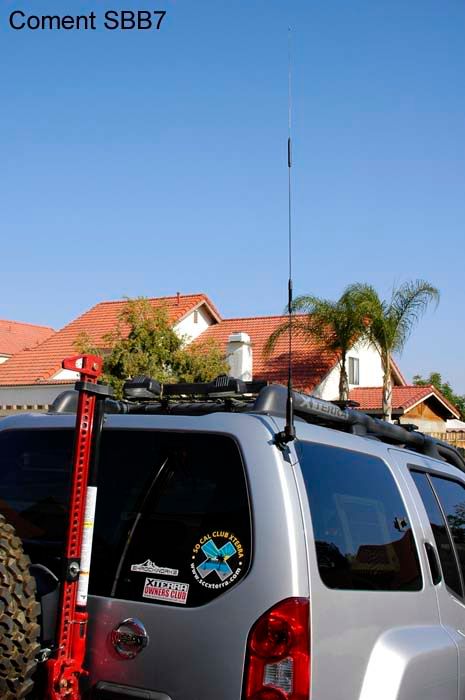OK men (and women

) I thought I would share some wisdom on radio communications with the group.
I've been into radio communications since 1975 (that's a couple years before the big CB craze caused by the movie Smokie and the Bandit). Currently I hold the highest FCC license issued in amateur radio the "extra class". I have worked professionally at both AM and FM radio stations for a long long time.

Communications (CAN YOU HEAR ME NOW?)
(above) Yaesu dual band amateur radio remote face plate and microphone.
I think one of the funnest parts of making our club runs is the radio chatter that we share. Sort of like sitting around the campfire at night but done creeping along the trail. The radio is also used by the trail leader and tail gunner to warn of those insane motorcyclist ripping through our group at 30 mph. It's also a nice way to send messages to both ends of the group: "stay left", "by-pass to the right", or "Paul's blown another tire, hang on". Our written by-laws* require that each truck have a functional FRS (Family Radio Service) walkie-talkie. These things run from $15 to about $60 with most being around $20-$25 with charger.
I'm going to discuss three types of radios: FRS, CB, and Amateur Radio (Ham).
Family Service RadioFRS radios are limited in power to 0.5 watts and use Ultra High Frequencies (UHF). They're typically good for about two to three miles across the flat and clear desert. Their tiny antennas and their UHF frequencies mean that they transmit pretty well out of the windows of our trucks. Some radios support an external antenna and these will greatly assist in both receiving and transmitting. But that half a watt of power isn't a bunch and even with good antennas and line-of-sight between two trucks I would guess that about 4-5 miles is all that half a watt is good for. Using the walkie-talkie antennas inside the canyons we romp though and the signals still tend to be line-of-sight, when someone goes around a corner or two ... they're gone from the radio. Those UHF signals don't "bounce" off of rocks very well. That said, YOU NEED TO HAVE AN FRS RADIO! Understand that many FRS radios have built-in GRMS channels but those actually require a license to transmit upon.

(above) A pair of Midland FRS radios and charger for $80.
Our FRS radios use the channel of the month: January we're on channel one, February we're on channel two ... and a "privacy code" of 24 for the 24th letter of the alphabet "X". If you lose communications with FRS and are lost step out of your truck and try to get to a high point quickly as getting out of the truck and above some of the canyon walls can help.
Note: a common and just flat-out wrong marketing claim is that these FRS radios are good for 20 or more miles. No.
Citizens Band RadioMany times (eight in fact!) better than FRS is Citizens Band (CB) radio. You no longer require a license for CB. CB's are limited to four watts of transmit power and use High Frequency (HF). Since the frequencies are lower (longer) on CB the antennas also need to be longer. The biggest mobile antennas are 108" long (102" plus a 6" spring) but per our by-laws* the big 102" whips are prohibited as they're very long and tend to whip from side-to-side hitting spectators along the trails. Of course there are shorter antennas like the popular "Firestiks" that are fiberglass with wire wound coils at the tops. They come in sizes from 3 feet to 6 feet. I have a couple of them and found that a 3 foot antenna mounted on the ShrockWorks bumper mount doesn't stick up above the roof. A four footer just clears the roof for a bit better transmit and receive range. CB radios run from about $40 to $300 with most between $80 and $130. A mount and antenna can run that much again. Some shops will (illegally) tweak them up to 6-8 watts worth of power. The combination of a good antenna and those 4 to 8 watts worth of power gives a good 6-12 mile range across the deserts. In the canyons the HF waves tend to bounce off the rocks a bit and aren't as line-of-sight at the FRS radios.
I have a tiny Midland CB that mounts inside the center console compartment with a big strip of velcro. Plug into the cigarette lighter plug in there and toss a $30 magnet mount on the roof with a base coil and a thin short 31" whip and you're going to be doing well. The CB is great on the highways as the truckers will use channel 19 to chit-chat about traffic, accidents, and "smokey!".

Communications (CAN YOU HEAR ME NOW?)
(above) Midland CB mounted in the center console.
We can't use channels 9 (emergency only) or 19 (highway truckers) and 16 and 17 are sometimes busy with Single Side Band (SSB) which is a different type of modulation that interferes with the AM used by CB if they're on the same channels. Since CBs are in the HF band they can experience some rather odd atmospheric behavior as the long wavelengths can actually bounce off of the ionosphere high above the earth and get tremendous ranges - hundred and sometimes thousands of miles. Unfortunately you can't count on the bounce and your reflected signal 100 miles away isn't going to be heard by someone just over the next ridge or two oddly enough.
Amateur Radio (Also Known as Ham)Amateur radio requires that you take a written test (only) and pay a $15 fee for a five year license. The test is so difficult that I have had 8 year old girls and 85 year old men pass it on their first shot! You do have to study some material to pass the test. Every single question is published by the FCC with the correct answer. Sort of like a driver's exam to get a driver's license. If you're near March ARB (Riverside) and want to test at a friendly place look up
www.k6afn.org as that's my ham club and I'll likely be at your testing session.
There are three classes of ham licenses: technician, general, and extra with each one requiring a more difficult and technical exam. The "best bang for your buck" is the technician's license at you get to transmit on more bands that you can count on with your fingers. The most popular of those bands are "2 Meters" (2M) and "440 MHz" (70 cm). Mobile radios for these frequencies start off at about $100 and run up to $1200 (with HF bands too). Most radios will run $120-$270 and will feature either one or both (more expensive) of those two bands. The most popular mobile ham radios are the 2M FM radios. They typically transmit 50 to 75 watts worth of power. The 2M antennas are a good middle ground between the tiny ones of the UHF FRS walkie-talkies and the giant ones of the CB. Using a 50 watt radio and a 30 inch antenna it's possible to talk 50-100 miles line-of-sight. I famously talked to someone in northern San Diego from Hungry Valley Park and the communications were so loud and clear I thought he was in our club! The FM modulation and higher quality radios make for a good "clean" sounding voice.

Communications (CAN YOU HEAR ME NOW?)
(above) Kenwood tri-band ham walkie-talkies
Unlike FRS and CB there aren't channels in ham but rather thousands of frequencies to use. Some of those have been set aside to use with repeaters. Using a repeater you transmit a single to a big antenna on a mountain. From there it's amplified and transmitted out on a different frequency. The frequencies are coordinated and the radios "automatically" transmit on one frequency and listen on the other. Using repeaters it's possible to talk from the beaches of Los Angeles out to Riverside 50 miles away with a 1W walkie-talkie. The repeaters are often the only radio communications available beyond cell phone range.
Our club tends to use 146.52 MHz on the 2M band. 146.52 is the "wilderness" channel that is encouraged to be used by hikes and off-roaders so that we can help each other if we have to do so. The amateur radios tend to be so high powered with good antenna that we actually turn the amplifiers down on the trail to not "blow out" the other guy just a half a mile away. I will run at five or ten watts worth of power on the trail. If needed we can always turn the power back up to the 50 to 75 watts most of these things have.

Communications (CAN YOU HEAR ME NOW?)
(above) Yaesu dual band radio mounted under the passenger's seat. The larger black box is the Rockford Fosgate audio amplifier.
There is a lot of science in the antennas of ham radio and a good antenna can really help. There are standard mounting types which allow a variety of antennas to be used. I have a NMO mount on my rear hatch. Around town under the repeaters I use a little 6" stubby antenna. Out on the trails I'll step up to a 38" antenna. I'll also carry a full-size high gain antenna velco strapped to my safari rack to put up in an emergency.
Another nice thing about ham radios is that many have remote mounting heads. The face plate detaches and can be mounted with velcro even placing the display in a convenient small spot while the rest of the radio "hides out" under a seat.
Those folks with ham radios on the trail are never out-of-touch with each other. In larger trail runs we need to have one ham behind the leader and another in front of the tail gunner. If there are additional hams they can fill in the middle and relay to FRS if needed.
I recommend
http://www.universal-radio.com/ for your ham radio shopping. Great web site and good prices.
Communication ProtocolWhen talking on the radio put the microphone about 1" from your mouth, squeeze the button, wait a half a second and then begin talking in a clear and normal voice. If two people talk at the same time it's called a "double" and both radios interfere with each other making it hard to understand either. If you "double" with another person stop and wait a bit of time and then transmit again. If the other person starts before you just wait.
If you have a CD playing please turn down the music when you transmit.
Try to wait one or two seconds before replying to someone. There maybe someone who needs to "break" into the conversation with something important.
In a true emergency please keep the channel clear unless you're actually involved with solving the emergency or working as a relay station. If you hear two folks who aren't hearing each other you're in the middle and may be able to function as a relay station. Listen to what one station tells you and carefully repeat it to the other. Not the easiest thing to do. The two stations on each end have to wait for the relay station to transmit, receive the far side, and then relay the message to back to the other end.
If passing something like a telephone number go very slowly and speak the numbers clearly. If passing letters try to use the alpha-bravo-charlie words help the far end hear the difference between similar sounding letters like "B""C" and "D".
The phrase
"May Day, May Day, May Day" has been reserved and is the international call for help when someone is in danger of life or limb. If you're hopelessly lost or injured calling out "May Day" on CB channels 9 and 19 is probably your best bet if within about 10 miles of the highway. Do the same on a repeater channel (you do carry an ARRL repeater guide book with you?) or on the "Wilderness Protocol" channel simplex is likely best on amateur radio. If you hear someone calling out a "May Day" you need to render as much assistance as possible.

Communications (CAN YOU HEAR ME NOW?)
(above) A 2M/440 Mhz dual band antenna on the rear hatch.
There's more than a handful of amateur radio operators in the club now and I'm certain they'd be willing to share their communications knowledge with you if you ask. I think that next to recovery points forward and aft good communications are next most important thing to have on our club runs.
Paul KG6OAZ
Amateur Extra
* yeah we have them!